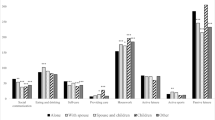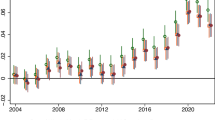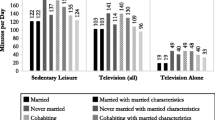Abstract
Whereas prior research focused on the beneficial effects of time spent with others, this study investigated the association between solitary time and mental health by hypothesizing about the possible detriments as well as benefits. Additionally, we studied whether the association between solitary time and mental health was nonlinear and moderated by gender and life stage. We hypothesized that whereas solitary time limits individuals’ access to social resources and support (decreasing mental health), it also helps individuals to recharge (enhancing mental health). We used the Dutch Time Use Survey from 2006 (N = 1,487). Results of Tobit models indicated that more solitary time in leisure (but not household labor) was associated with a reduction in mental health. For men, we did find a negative association between alone time in household labor and mental health. There was no evidence for a curvilinear relationship between time alone and mental health, nor did life course stage appeared to moderate this association.

Similar content being viewed by others
References
Almedom, A. M. (2005). Social capital and mental health: An interdisciplinary review of primary evidence. Social Science and Medicine, 61(5), 943–964.
Bakker, A. B., Demerouti, E., & Schaufeli, W. B. (2002). Validation of the Maslach burnout inventory—general survey: An internet study. Anxiety, Stress & Coping, 15(3), 245–260.
Ben-Ari, A. (2012). Rethinking closeness and distance in intimate relationships: Are they really two opposites? Journal of Family Issues, 33(3), 391–412.
Bianchi, S. M., & Milkie, M. A. (2010). Work and family research in the first decade of the 21st century. Journal of Marriage and Family, 72(3), 705–725.
Bianchi, S. M., Robinson, J. P., & Milkie, M. A. (2006). Changing rhythms of American family life. New York: Russell Sage Foundation.
Bittman, M., & Wajcman, J. (2000). The rush hour: The character of leisure time and gender equity. Social Forces, 79(1), 165–189.
Brambor, T., Clark, W. R., & Golder, M. (2006). Understanding interaction models: Improving empirical analyses. Political Analysis, 14, 63–82.
Bryant, W. K., & Wang, Y. (1990). Time together, time apart: An analysis of wives’ solitary time and shared time with spouses. Journal of Family and Economic Issues, 11(1), 89–119.
Cloïn, M. (2012). A day with the Dutch. Den Haag: Sociaal en Cultureel Planbureau.
Coleman, J. S. (1990). Foundations of social theory. Cambridge, MA: Harvard University Press.
Coleman, J. S. (1994). Foundations of social theory. Cambridge, MA: Harvard University Press.
Conger, R. D., Conger, K. J., & Martin, M. J. (2010). Socioeconomic status, family processes, and individual development. Journal of Marriage and Family, 72(3), 685–704.
Craig, L. (2006). Does father care mean fathers share? A comparison of how mothers and fathers in intact families spend time with children. Gender & Society, 20(2), 259–281.
Demir, M., Özen, A., Doğan, A., Bilyk, N. A., & Tyrell, F. A. (2010). I matter to my friend, therefore I am happy: Friendship, mattering, and happiness. Journal of Happiness Studies, 12(6), 983–1005.
DeVault, M. L. (2000). Producing family time: Practices of leisure activity beyond the home. Qualitative Sociology, 23(4), 485–503.
Gager, C. T., & Sanchez, L. (2003). Two as one? Couples’ perceptions of time spent together, marital quality, and the risk of divorce. Journal of Family Issues, 24(1), 21–50.
Gauthier, A. H., Smeeding, T. M., & Furstenberg, F. F, Jr. (2004). Are parents investing less time in children? Trends in selected industrialized countries. Population and Development Review, 30(4), 647–672.
Haller, M., Hadler, M., & Kaup, G. (2012). Leisure time in modern societies: A new source of boredom and stress? Social Indicators Research, 111(2), 403–434.
Heller, N. (2012) The disconnected. In The New Yorker, April 16.
Hill, M. S. (1988). Marital stability and spouses’ shared time. Journal of Family Issues, 9(4), 427–451.
Jehoel-Gijsbers, G. (2004). Sociale uitsluiting in Nederland. [Social exclusion in the Netherlands] The Hague: Netherlands Institute for Social Research | scp (scp-publication 2004/17).
Johnston, D. D., & Swanson, D. H. (2006). Constructing the ‘good mother’: The experience of mothering ideologies by work status. Sex Roles, 54(7–8), 509–519.
Kahneman, D., & Krueger, A. B. (2006). Developments in the measurement of subjective well-being. Journal of Economic Perspectives, 20(1), 3–24.
Kahneman, D., Krueger, A. B., Schkade, D. A., Schwarz, N., & Stone, A. A. (2004). A survey method for characterizing daily life experience. Science, 306, 1776–1780.
Kalmijn, M. (2003). Shared friendship networks and the life course: An analysis of survey data on married and cohabiting couples. Social Networks, 25(3), 231–249.
Kalmijn, M., & Bernasco, W. (2001). Joint and separated lifestyles in couple relationships. Journal of Marriage and Family, 63(3), 639–654.
Kingston, P. W., & Nock, S. L. (1987). Time together among dual-earner couples (pp. 391–400). American Sociological Review.
Kraaykamp, G., van Gils, W., & Van Der Lippe, T. (2009). Working status and leisure: An analysis of the trade-off between solitary and social time. Time & Society, 18(2–3), 264–283.
Labianca, G., Brass, D. J., & Gray, B. (1998). Social networks and perceptions of intergroup conflict: The role of negative relationships and third parties. Academy of Management Journal, 41(1), 55–67.
Langelaan, S., Bakker, A. B., van Doornen, L. J. P., & Schaufeli, W. B. (2006). Burnout and work engagement: Do individual differences make a difference? Personality and Individual Differences, 40(3), 521–532.
Larson, R. W., Gillman, S. A., & Richards, M. H. (1997). Divergent experiences of family leisure: Fathers, mothers, and young adolescents. Journal of Leisure Research, 29(1), 78–97.
Leary, M. R., Herbst, K. C., & McCray, F. (2003). Finding pleasure in solitary activities. Personally and Individual Differences, 35(1), 59–68.
Macmillan, R., & Copher, R. (2005). Families in the life course. Journal of Marriage and Family, 67(4), 858–879.
Mattingly, M. J., & Blanchi, S. M. (2003). Gender differences in the quantity and quality of free time: The US experience. Social Forces, 81(3), 999–1030.
McPherson, M., Smith-Lovin, L., & Brashears, M. E. (2006). Social isolation in America: Changes in core discussion networks over two decades. American Sociological Review, 71(3), 353–375.
Miller, Y. D., & Brown, W. J. (2005). Determinants of active leisure for women with young children: An ‘ethic of care’ prevails. Leisure Sciences, 27(5), 405–420.
Minnen, J., Van Tienhoven, T., Glorieux, I., & Daniels, S. (2012). Samen doen of samen zijn? Over arbeids- en gezinsverantwoordelijkheden en de tijd die partners samen doorbrengen. Tijdschrift voor Sociologie, 33(4), 381–403.
Moen, P. (2003). It’s about time: Couples and careers. Ithaca, NY: Cornell University Press.
Nomaguchi, K. M., & Bianchi, S. M. (2004). Exercise time: Gender differences in the effects of marriage, parenthood, and employment. Journal of Marriage and Family, 66(2), 413–430.
Offer, S., & Schneider, B. (2011). Revisiting the gender gap in time-use patterns: Multitasking and well-being among mothers and fathers in dual-earner families. American Sociological Review, 76(6), 809–833.
Patulny, R. & Fisher, K. (2012). Advancing wellbeing research: Would Americans be happier if they lived like Australians? Australian Journal of Social Issues, 47, 29–50.
Robinson, J. P., & Godbey, G. (1997). Time for life: The surprising ways Americans use their time. University Park: Pennsylvania State University Press.
Rook, K. S. (1984). The negative side of social interaction. Journal of Personality and Social Psychology, 46(5), 1097–1108.
Roxburgh, S. (2006). ‘I wish we had more time to spend together’: The distribution and predictors of perceived family time pressures among married men and women in the paid labor force. Journal of Family Issues, 27(4), 529–553.
Seery, B. L., & Crowley, M. S. (2000). Women’s emotion work in the family: Relationship management and the process of building father-child relationships. Journal of Family Issues, 21(1), 100–127.
Sevilla, A., Gimenez-Nadal, J. I., & Gershuny, J. (2012). Leisure inequality in the United States: 1965–2003. Demography, 49(3), 939–964.
Treas, J., Van der Lippe, T., & Tai, T. C. (2011). The happy homemaker? Married women’s well-being in cross-national perspective. Social Forces, 90(1), 111–132.
Umberson, D., Meichu, D., House, J. S., Hopkins, K., & Slaten, E. (1996). The effect of social relationships on psychological well-being. American Sociological Review, 61(5), 837–857.
Van Gaalen, R. I., & Dykstra, P. A. (2006). Solidarity and conflict between adult children and parents: A latent class analysis. Journal of Marriage and Family, 68(4), 947–960.
Author information
Authors and Affiliations
Corresponding author
Rights and permissions
About this article
Cite this article
Roeters, A., Cloïn, M. & van der Lippe, T. Solitary Time and Mental Health in the Netherlands. Soc Indic Res 119, 925–941 (2014). https://doi.org/10.1007/s11205-013-0523-4
Accepted:
Published:
Issue Date:
DOI: https://doi.org/10.1007/s11205-013-0523-4




